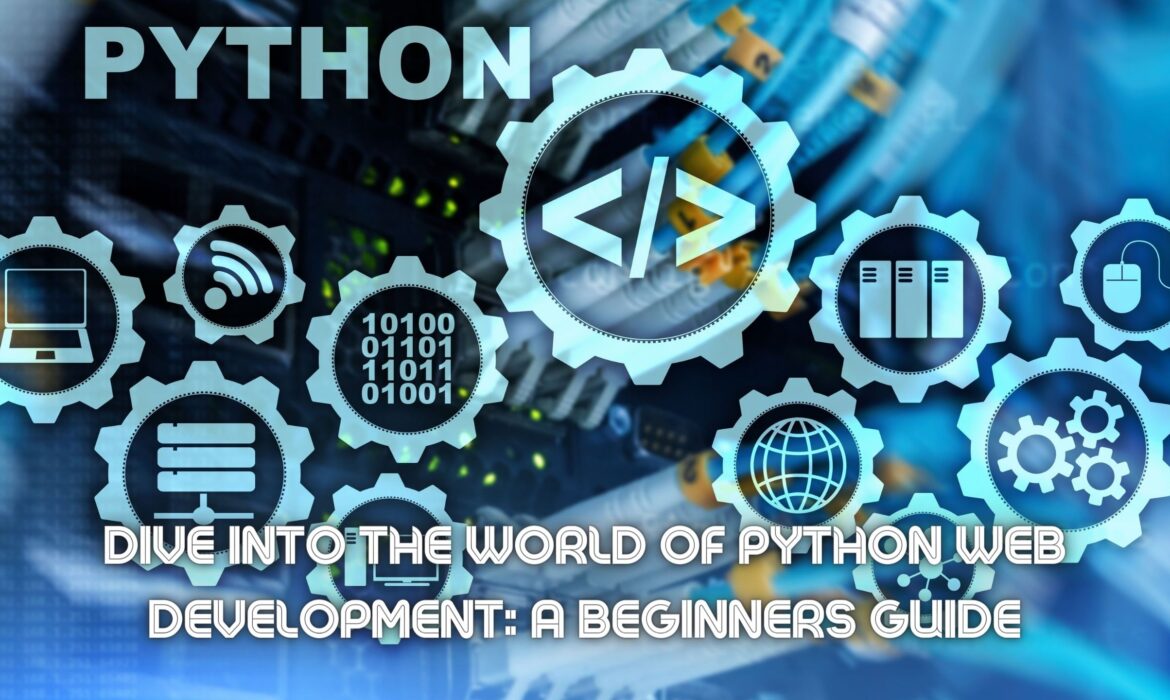
Introduction to Python Web Development
When it comes to web development, Python is a powerful and versatile programming language that has gained immense popularity. Its simplicity, readability, and extensive library ecosystem make it an excellent choice for building web applications. In this section, we will explore why Python is a great option for web development and introduce popular Python web development frameworks.
Why Choose Python for Web Development
Python’s popularity in web development can be attributed to several factors. Firstly, Python is a high-level, interpreted, and dynamically typed programming language, which means that it is easy to learn and write code in. Its syntax is clear and concise, making it readable and allowing developers to express their ideas more effectively.
Another advantage of Python is its extensive library support. Python boasts a vast collection of libraries and frameworks that simplify web development tasks, allowing developers to build applications more efficiently. These libraries cover a wide range of functionalities, including front-end web development, responsive web design, and back-end web development, providing developers with the tools they need to create robust and feature-rich web applications.
Python’s simplicity and readability also make it an ideal choice for beginners learning web development. The language’s clear syntax and easy-to-understand code structure enable newcomers to grasp web development concepts more easily, allowing them to quickly start building their own projects.
Popular Python Web Development Frameworks
Python web development is made even more accessible and efficient through the use of various frameworks. These frameworks provide a structured way of building web applications, offering pre-built components and tools that simplify the development process.
Some of the most popular Python web development frameworks include:
| Framework | Description |
|---|---|
| Django | A robust web framework that follows the Model-View-Controller (MVC) architectural pattern. Django offers a comprehensive set of features and tools for building secure and scalable web applications. |
| Flask | A lightweight and flexible framework that focuses on simplicity and minimalism. Flask is well-suited for small to medium-sized projects and allows developers to have more control over the application’s structure. |
| Pyramid | A flexible and scalable framework that supports a wide range of web development needs. Pyramid emphasizes flexibility, making it suitable for projects of any size and complexity. |
| CherryPy | A minimalist and performance-focused framework that prioritizes speed and efficiency. CherryPy is known for its simplicity and can be a good choice for small projects or when performance is a critical factor. |
| Bottle | A micro-framework designed for small projects and quick prototyping. Bottle has a small footprint and minimal dependencies, making it easy to get started and work on small-scale applications. |
These frameworks provide developers with the necessary tools and features to build web applications efficiently and effectively. Choosing the right framework depends on the specific requirements of your project and the level of control and scalability needed.
In the following sections, we will dive deeper into these frameworks and explore their features and use cases. Whether you are a beginner or an experienced developer, Python web development offers an array of options to suit your needs and preferences.
Getting Started with Python Web Development
To embark on your journey in Python web development, it’s important to have a clear path and access to learning resources. In this section, we will explore various learning resources and paths to help you get started. Additionally, we’ll highlight some practical projects that you can undertake to gain hands-on experience in Python web development.
Learning Resources and Paths
When it comes to learning Python web development, there are numerous resources available to suit different learning styles and preferences. Here are a few popular options:
-
Online Courses: Platforms like Real Python offer comprehensive courses that cover various aspects of Python web development. These courses provide structured learning paths and practical examples to enhance your understanding.
-
Documentation: The official documentation for frameworks like Django and Flask serve as valuable resources for learning Python web development. They provide detailed explanations, tutorials, and examples to guide you through the process of building web applications.
-
Tutorial Websites: Online tutorial websites, such as Real Python, offer a wide range of tutorials and articles that cover different topics in Python web development. These resources often provide step-by-step instructions and code examples to help you grasp the concepts effectively.
-
Books: There are several books available that cater to beginners in Python web development. These books provide comprehensive coverage of the subject matter and often include exercises and projects to reinforce your learning.
Whichever learning resource you choose, it’s important to follow a structured learning path that covers the fundamentals before diving into more advanced topics. This will ensure a solid foundation for your Python web development journey.
Building a Portfolio App with Django
One practical project to undertake when learning Python web development is building a portfolio application with Django. This project allows you to showcase your skills and create a professional online presence. The course “Get Started With Django: Build a Portfolio App” by Real Python is a great resource for this project. It teaches the basics of creating web applications with Django and includes building a portfolio website with a fully functioning blog.
Creating a Location-Based Web App with Django and GeoDjango
Another exciting project to explore is creating a location-based web application using Django and GeoDjango. This project involves integrating geographical data into your web app, enabling features like finding nearby shops or services. The course “Make a Location-Based Web App With Django and GeoDjango” by Real Python provides a comprehensive guide for this project. It covers using Django and GeoDjango to build a location-based web application, specifically a nearby shops application.
Building HTTP APIs with Django REST Framework
If you’re interested in building web APIs, the Django REST Framework is a powerful tool to explore. It simplifies the process of creating RESTful APIs, reducing the amount of code needed to create REST interfaces. The course “Building HTTP APIs With Django REST Framework” by Real Python focuses on using Django REST Framework to build HTTP APIs. This course provides hands-on examples and best practices for building robust APIs.
Python REST APIs with Flask, Connexion, and SQLAlchemy
Flask is another popular web framework for Python that offers a lightweight and flexible approach to web development. If you’re interested in building REST APIs, the tutorial series “Python REST APIs With Flask, Connexion, and SQLAlchemy” by Real Python is a valuable resource. It guides learners in creating a RESTful API from scratch using Flask, Connexion, and SQLAlchemy. The tutorial series also covers testing the API with Swagger UI API documentation.
By exploring these learning resources and undertaking practical projects, you can gain a solid foundation in Python web development. Remember to practice regularly, experiment with different frameworks, and continuously expand your knowledge to become proficient in this exciting field.
Python vs. Java for Web Development
When it comes to web development, both Python and Java are popular programming languages that offer unique features and capabilities. Let’s take a closer look at the overview, benefits, and challenges of using Python and Java for web development.
Overview of Python and Java
Python is a high-level, interpreted, and dynamically typed programming language known for its simplicity, scalability, and readability in web development. It offers a wide range of libraries and frameworks that facilitate the development process and enable rapid prototyping. Python’s clean syntax and easy-to-understand code make it a popular choice for beginners and experienced developers alike.
Java, on the other hand, is a general-purpose, class-based, and object-oriented programming language. It is renowned for its solid performance and speed in web development. Java’s robustness and scalability make it a preferred choice for large-scale enterprise applications. Additionally, Java’s platform independence allows it to be used across different operating systems and devices.
Benefits of Python for Web Development
Python brings several benefits to web development. Its easy-to-learn syntax and extensive community support make it accessible to developers of all levels of expertise. Python offers a vast collection of libraries and frameworks, such as Django and Flask, which streamline the development process and provide powerful tools for building web applications. The execution speed of Python is also noteworthy, allowing for efficient and responsive web applications.
Benefits of Java for Web Development
Java’s benefits in web development lie in its platform independence, robustness, and scalability. Java applications can run on any platform with a Java Virtual Machine (JVM), making them highly portable. The language’s strong typing system and extensive libraries make it suitable for building complex and secure web applications. Java’s performance and scalability make it an ideal choice for enterprise-level applications that require high reliability and stability.
Challenges of Python for Web Development
While Python offers numerous advantages, it does come with some challenges. One of the main challenges is the Global Interpreter Lock (GIL), which restricts the execution of multiple threads in parallel. This can impact the performance of certain applications that heavily rely on parallel processing. Additionally, Python’s dynamic typing can lead to potential runtime errors that may require careful testing and debugging.
Challenges of Java for Web Development
Java also presents its own set of challenges in web development. The learning curve for Java can be steep for beginners due to its strict syntax and object-oriented nature. Additionally, Java’s verbosity requires writing more lines of code compared to other languages, which can increase development time. However, modern frameworks like Spring have simplified Java web development by providing more concise and declarative programming options.
By understanding the benefits and challenges of Python and Java in web development, developers can make informed decisions based on their project requirements and personal preferences. Both languages offer powerful tools and frameworks that can cater to a wide range of web development needs.
Exploring Python Web Development Frameworks
When it comes to Python web development, there are several frameworks available that can simplify the process and enhance your productivity. Let’s take a closer look at some popular Python web development frameworks:
Django: A Robust Web Framework
Django stands out as a widely used high-level Python web framework known for its robustness, scalability, and security features. It provides a complete set of tools and libraries that enable developers to build complex and feature-rich web applications. Django’s batteries-included approach includes an ORM (Object-Relational Mapping) for database management, built-in authentication system, and a templating engine, making it a versatile choice for a wide range of projects.
Flask: Lightweight and Flexible
Flask is a lightweight and flexible Python web framework that appeals to developers for its simplicity and ease of use. It is well-suited for small to medium-sized web applications and offers the freedom to choose the components you need, allowing for a more personalized development experience. Flask’s minimalist approach makes it easy to understand and get started with, making it a popular choice among developers.
Pyramid: Flexible and Scalable
Pyramid is a flexible and scalable Python web framework that caters to both small and large web applications. It is known for its simplicity and ease of use, allowing developers to quickly build applications without unnecessary complexity. Pyramid’s flexibility is one of its main advantages, as it allows developers to choose the components they need, making it a great choice for projects of different sizes and requirements.
CherryPy: Minimalist and Performance-Focused
CherryPy is a minimalist Python web framework that focuses on performance and simplicity. It provides the core functionality needed for web development without the extra features found in larger frameworks. CherryPy is designed to be lightweight, making it suitable for small projects and applications where performance is a top priority.
Bottle: A Micro-Framework for Small Projects
Bottle is a micro-framework that emphasizes simplicity and minimalism. It is specifically designed for small-scale projects and provides a lightweight and straightforward solution for building web applications. Despite its small size, Bottle still offers features such as routing, templating, and URL dispatching, making it a viable option for small projects or APIs.
These are just a few examples of the Python web development frameworks available. Each framework has its own unique features and advantages, allowing developers to choose the one that best fits their project requirements and coding preferences. Whether you opt for Django’s robustness, Flask’s simplicity, Pyramid’s flexibility, CherryPy’s performance focus, or Bottle’s lightweight approach, Python provides a range of options for building web applications efficiently and effectively.
Real-World Examples of Python Web Development
Python has established itself as one of the most popular programming languages for web development, thanks to its simplicity, readability, and extensive library support (Data Science Central). Let’s explore some real-world examples of how Python is being used in the web development industry.
Python in Web Development Industry
Python’s versatility and robustness make it a powerful tool for web development. Its popularity continues to grow as developers recognize its capabilities in creating efficient and scalable web applications. Python’s Django framework, in particular, stands out for its robustness and scalability, making it a preferred choice for building large and complex web applications (Data Science Central).
One of the key advantages of Python in web development is its extensive library support. Python boasts a rich ecosystem of libraries, such as NumPy, Pandas, and Scikit-learn, which allow developers to easily integrate data analysis and machine learning capabilities into their web applications (Data Science Central). This flexibility opens up opportunities for building intelligent and data-driven web solutions.
However, Python may not be the best choice for high-performance, real-time applications that require low-level programming or fine-grained control over system resources (Data Science Central). It’s essential to consider the specific requirements of the project before deciding on the programming language.
Popular Websites Built with Python
Python has been leveraged by several high-profile websites to power their backend systems. Let’s take a look at some popular websites that rely on Python for their web development needs:
| Website | Description |
|---|---|
| The world’s largest Django web framework deployment, entirely written in Python (Tinkerly). | |
| Spotify | Utilizes Python for 80% of its backend services and for data analytics using the Luigi package (Tinkerly). |
| Dropbox | Relies on Python for its cloud-based platform, benefiting from its cross-platform support, readability, and ease of learning (Tinkerly). |
| Netflix | Uses Python for managing network devices, information security tasks, and machine learning applications (Tinkerly). |
| Bitly | The most used URL shortener globally, built entirely using Python web programming (Tinkerly). |
| Quora | Employs Python for both the frontend and backend interface of its website, providing better readability and efficiency compared to PHP (Tinkerly). |
These examples demonstrate the versatility of Python in handling diverse web development needs, from social media platforms to cloud-based services and beyond.
Success Stories of Python Web Development
Python’s success in the web development industry extends beyond individual websites. It has played a significant role in enabling developers to build innovative and efficient web solutions. The success stories of Python web development include:
- Simplifying the development process: Python’s clean syntax and readability contribute to faster development cycles and improved productivity.
- Enabling rapid prototyping: Python’s extensive library support and easy integration with other technologies make it ideal for quickly building and testing web applications.
- Empowering data-driven applications: Python’s robust data analysis and machine learning libraries allow developers to incorporate intelligent features into their web solutions, opening up new possibilities.
- Driving the growth of web frameworks: Python web frameworks like Django, Flask, Pyramid, CherryPy, and Bottle have gained popularity for their ease of use, scalability, and flexibility.
These success stories highlight the value of Python in web development and its ability to empower developers to create cutting-edge web solutions.
Python’s web development capabilities continue to evolve, making it an exciting language for both beginners and experienced developers to explore. With its versatility, extensive library support, and a vibrant community, Python is well-positioned to shape the future of web development.
Exploring Python Web Development Frameworks
Python offers a wide range of web development frameworks that cater to different needs and preferences. These frameworks provide developers with the tools and libraries necessary to build robust and scalable web applications. Let’s explore some of the popular Python web development frameworks available.
Django: A Robust Web Framework
Django stands out as one of the most popular Python web development frameworks. It is known for its simplicity, scalability, and extensive feature set. Django follows a batteries-included approach, providing developers with everything they need to build complex web applications without having to reinvent the wheel. With its robust security features, built-in admin interface, and powerful ORM (Object-Relational Mapping) capabilities, Django is an excellent choice for both small-scale and large-scale projects.
Flask: Lightweight and Flexible
Flask is a lightweight and flexible Python web development framework. It is designed to be simple and easy to use, making it a great choice for beginners or projects with minimal requirements. Flask provides the basics needed for web development and allows developers to add or remove components as needed, making it highly customizable. Despite its simplicity, Flask is powerful enough to handle a wide range of applications, including REST APIs and small-scale web projects.
Pyramid: Flexible and Scalable
Pyramid is a flexible and scalable Python web development framework. It follows a minimalist approach, providing developers with the freedom to choose the tools and libraries they prefer. Pyramid is known for its versatility and ability to handle projects of any size or complexity. It offers a robust set of features, including URL routing, templating, and authentication, while maintaining simplicity and performance.
CherryPy: Minimalist and Performance-Focused
CherryPy is a minimalist Python web development framework that focuses on performance and simplicity. It provides a straightforward way to build web applications with minimal boilerplate code. CherryPy’s modular design allows developers to add functionality as needed, making it a suitable choice for small-scale projects or when performance is a priority. Despite its simplicity, CherryPy is still capable of handling complex applications.
Bottle: A Micro-Framework for Small Projects
Bottle is a micro-framework designed for small-scale web applications. It is known for its simplicity and compact size. Bottle has a minimalistic approach, making it easy to learn and use. It provides essential features such as routing, templating, and request handling, while keeping the codebase small and lightweight. Bottle is often used for quick prototyping, small APIs, or projects with minimal requirements.
These are just a few examples of the Python web development frameworks available. Each framework has its own strengths and is suited for different types of projects. Whether you choose Django for its robustness, Flask for its simplicity, or any other framework based on your project requirements, Python provides a rich ecosystem of tools and libraries to support your web development journey.
 ডিজিটাল মার্কেটিং অটোমেশন: সময় এবং সংস্থান সাশ্রয়by Freelancertamal●February 21, 2024
ডিজিটাল মার্কেটিং অটোমেশন: সময় এবং সংস্থান সাশ্রয়by Freelancertamal●February 21, 2024 email automationby Freelancertamal●February 19, 2024
email automationby Freelancertamal●February 19, 2024 Maximize Your Conversion Ratesby Freelancertamal●February 12, 2024
Maximize Your Conversion Ratesby Freelancertamal●February 12, 2024 Unleash Your Websites Potential: Meet the Expert Local SEO Consultant in Bangladeshby Freelancertamal●February 6, 2024
Unleash Your Websites Potential: Meet the Expert Local SEO Consultant in Bangladeshby Freelancertamal●February 6, 2024






